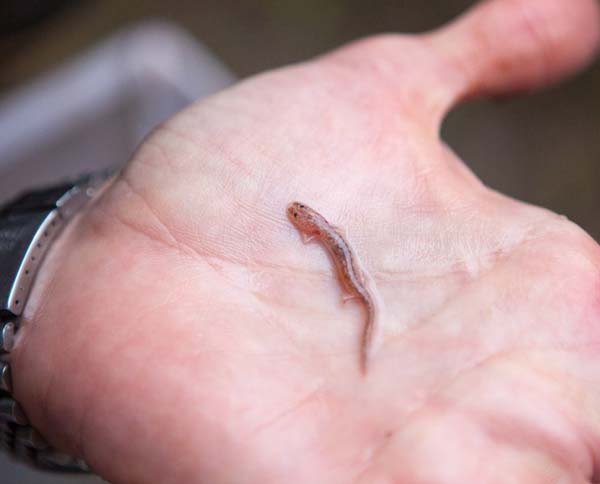5% of profits support Endangered & Threatened Species.
The Barton Springs Salamander is found only in the Barton Springs segment of the Edwards Aquifer and its contributing zone....

©Juliet Whitsett |Social: @juliet_whitsett_art
COLOR PALETTE SAMPLED FROM IMAGES OF THE BARTON SPRINGS SALAMANDER.

SPECIES INFO:
"The scientific name, Eurycea sosorum, was given to the Barton Springs Salamander in honor of the Austinites that initiated the Save Our Springs (SOS) ordinance, to protect the Edwards Aquifer that feeds Barton Springs. These salamanders spend their entire lives in the water, sporting external gills and a broad tail fin. They are covered in a cosmic array of mottling which is unique to each individual, like a fingerprint. Females lay about 20 eggs at a time, each one is carefully stuck onto a rock or vegetation. Babies hatch before they have fully developed hind limbs and must fend for themselves as there is no parental care after the eggs are laid. Overpumping of the aquifer and water pollution are the greatest threat to this beautiful species."
- Brittany A. Dobbins, Department of Biology, Texas State University
______________________________
According to TPWD "A slender, long-limbed salamander, about 2.5 inches in total length, with a small narrow head and greatly reduced eyes. They vary in color, and can be dark gray, gray, purplish-gray, gray-brown, or yellowish-brown. Most individuals have a dark "salt-and-pepper" mottling on their back. These salamanders have external gills which are red in color. The Barton Springs Salamander is entirely aquatic throughout its life."
"Because the Barton Springs Salamander relies on the clear, pure water of the Barton Springs Aquifer, protection of the quality and quantity of water flowing from Barton Springs is essential for its survival. Threats to water quality such as urban runoff, increased development in the Barton Creek watershed, and the risks of a toxic chemical spill or sewer line breakage in the urban zone surrounding Barton Springs remain a concern. Also of concern are reduced groundwater supplies due to increased urban water use."
"Residents and visitors to Austin will be happy to know that swimming in Barton Springs Pool does not pose a threat to the salamander or its habitat. With proper management, the pool will continue to provide refreshing enjoyment for people and habitat for the Barton Springs Salamander." -TPWD

Barton Springs salamander caught at Sunken Garden. Although the animals have evolved to spend their entire lives underwater, they can survive out of the water for brief periods.
18 Second Video of the Barton Springs Salamander:
RANGE:
According to austintexas.gov: "Although some of the first specimens of the Barton Springs Salamander were collected in 1946, the species was not formally described until 1993... The Barton Springs Salamander occurs in all four of the springs, collectively known as Barton Springs, in Zilker Park. This includes Parthenia Spring in Barton Springs Pool, Eliza, Old Mill (Sunken Garden), and Upper Barton."
WATCH:
Biologists Laurie Dries and Todd Jackson study the federally endangered Barton Springs salamander, an aquatic amphibian found only at Barton Springs.
SUPPORT:
Shop this art: HERE OR gift to the Threatened Texas Series: Venmo @Juliet-Whitsett (Your patronage donation helps spread the word about Texas' Endangered & Threatened Species)THREATENED TEXAS SERIES:
There are 148 Threatened Species & 74 Threatened Species in Texas. Each palette & species is unique. I have sampled colors from images of actual Texas Threatened Species and created original art inspired by each group. 5% of the profits from this series enthusiastically goes to help Threatened & Endangered Species.
HOW YOU CAN HELP:
Wonder what you can do to help? One easy thing I have found is to write my US house Rep. and ask them to support The Recovering America's Wildlife Act RAWA Find out more at https://www.txwildlifealliance.org/or if you aren't in Texas, https://ournatureusa.com/
SOURCES:
https://www.austintexas.gov/department/barton-spri...

